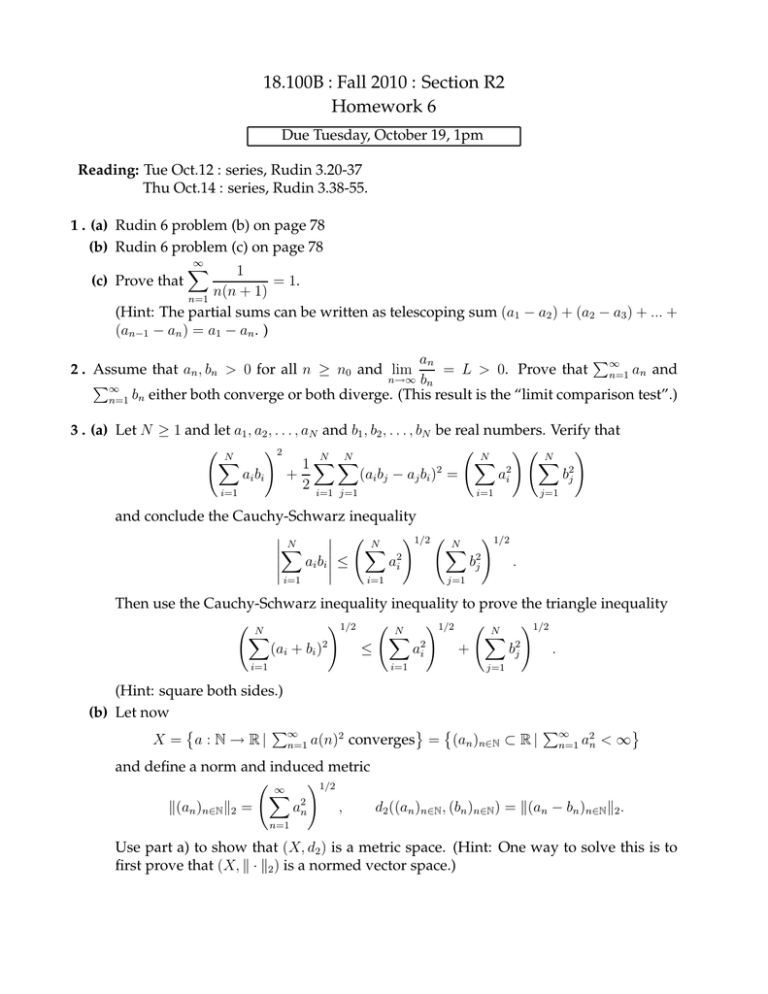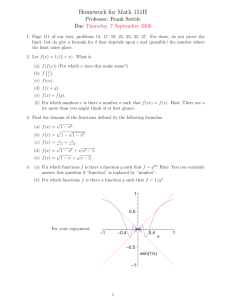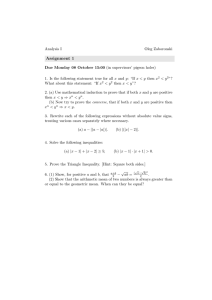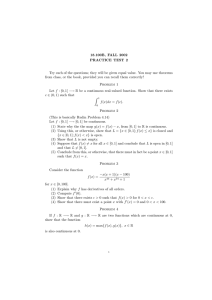Document 13584282
advertisement

18.100B : Fall 2010 : Section R2 Homework 6 Due Tuesday, October 19, 1pm Reading: Tue Oct.12 : series, Rudin 3.20-37 Thu Oct.14 : series, Rudin 3.38-55. 1 . (a) Rudin 6 problem (b) on page 78 (b) Rudin 6 problem (c) on page 78 ∞ � 1 (c) Prove that = 1. n(n + 1) n=1 (Hint: The partial sums can be written as telescoping sum (a1 − a2 ) + (a2 − a3 ) + ... + (an−1 − an ) = a1 − an . ) � an 2 . Assume that an , bn > 0 for all n ≥ n0 and lim = L > 0. Prove that ∞ n=1 an and n→∞ bn �∞ n=1 bn either both converge or both diverge. (This result is the “limit comparison test”.) 3 . (a) Let N ≥ 1 and let a1 , a2 , . . . , aN and b1 , b2 , . . . , bN be real numbers. Verify that � N �� N � � N �2 N N � � � 1 �� (ai bj − aj bi )2 = a2i b2j ai bi + 2 i=1 j=1 i=1 j=1 i=1 and conclude the Cauchy-Schwarz inequality � � � �1/2 � N �1/2 N N �� � � � � � ai bi � ≤ a2i b2j . � � � i=1 i=1 j=1 Then use the Cauchy-Schwarz inequality inequality to prove the triangle inequality � N �1/2 � N �1/2 � N �1/2 � � � (ai + bi )2 ≤ a2i + b2j . i=1 i=1 j=1 (Hint: square both sides.) (b) Let now � � � � � �∞ 2 2 X = a : N → R| ∞ a(n) converges = (a ) ⊂ R | a < ∞ n n∈N n=1 n=1 n and define a norm and induced metric �∞ �1/2 � k(an )n∈N k2 = a2n , d2 ((an )n∈N , (bn )n∈N ) = k(an − bn )n∈N k2 . n=1 Use part a) to show that (X, d2 ) is a metric space. (Hint: One way to solve this is to first prove that (X, k · k2 ) is a normed vector space.) 4 . (a) Rudin problem 9(a) and (c) on page 79. (Hint:ratio test) (b) For both power series, also investigate the convergence on the border of the radius of convergence (for |z| = R). 5 . Banach fixed-point theorem: Let (X, d) be a complete metric space. Suppose f : X → X has the property that, for some number c ∈ (0, 1), d(f (x), f (y)) ≤ c · d(x, y) for all x, y ∈ X. (a) Suppose yn ∈ X is any convergent sequence, with limit y. Prove that f (yn ) is a con­ vergent sequence, and f (yn ) → f (y). (b) Fix any point x0 ∈ X, and iteratively define xn+1 = f (xn ) for each n ∈ N. Show that ∞ � d(xj+1 , xj ) j=0 is a convergent series. [Hint: it is bounded above by a geometric series.] (c) Show that the sequence (xn ) of iterates of f starting at x0 , as above, is a Cauchy se­ quence. Conclude that it converges to some point x∞ ∈ X. [Hint: Let m, n ∈ N, and n suppose m ≥ n. Then m = n + k for some k ∈ N. Show that m , xn ) ≤ c · d(xk , x0 ), �d(x and d(xk , x0 ) ≤ d(xk , xk−1 )+d(xk−1 , xk−2 )+· · ·+d(x1 , x0 ) ≤ ∞ j=0 d(xj+1 , xj ). Conclude that d(xm , xn ) → 0 as m, n → ∞.] (d) Show that, given any starting point x0 , the limit x∞ of the sequence of iterates in (c) is a fixed-point of f : i.e. f (x∞ ) = x∞ . [Hint: using part (a), compare d(f (x∞ ), x∞ ) to d(f (xn ), xn ).] (e) Let x0 , y0 be any two points in X. Let xn+1 = f (xn ) and yn+1 = f (yn ) be the sequences of iterates. Show that d(xn , yn ) → 0 as n → ∞. Conclude that x∞ = y∞ , and that f has a unique fixed point. 2 MIT OpenCourseWare http://ocw.mit.edu 18.100B Analysis I Fall 2010 For information about citing these materials or our Terms of Use, visit: http://ocw.mit.edu/terms.





